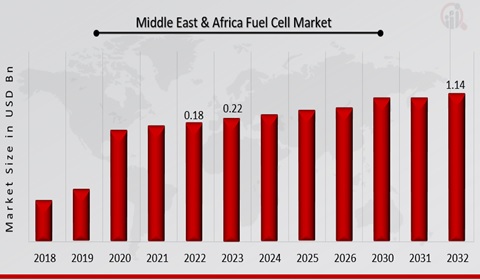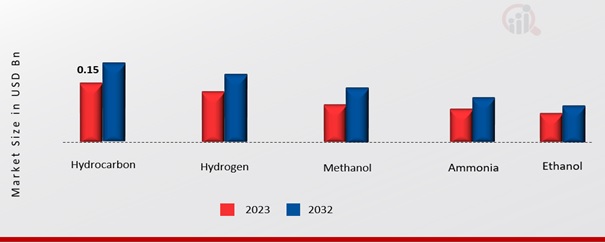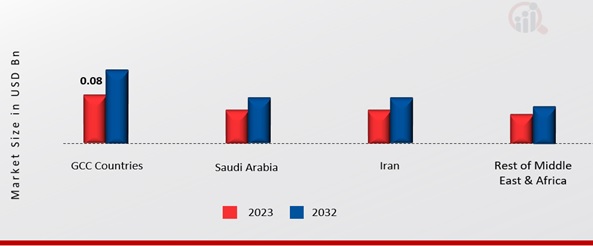Middle East & Africa Fuel Cell Market Overview
Middle East & Africa's Fuel Cell Market Size was valued at USD 0.18 Billion in 2022. The Global Middle East & Africa Fuel Cell market industry is projected to grow from USD 0.22 Billion in 2023 to USD 1.14 Billion by 2032, exhibiting a compound annual growth rate (CAGR) of 22.80% during the forecast period (2024 - 2032). Increasing demand for fuel cell vehicles is one of the major market drivers driving the Middle East & Africa Fuel Cell market. The growing necessity for green energy sources is driving the market growth.

Source: Secondary Research, Primary Research, MRFR Database and Analyst Review
Middle East & Africa Fuel Cell Market Trends
-
Growing demand for green hydrogen is driving the market growth
The Middle East & African Fuel Cell market CAGR is expanding because renewable energy resources like solar and wind power are abundant across the Middle East and Africa. The region's objectives to lower carbon emissions and switch to cleaner energy options are in line with the focus on green hydrogen generation using renewable energy sources. Green hydrogen is regarded as a flexible and sustainable energy source since it is created through electrolysis using renewable energy. This green hydrogen must be converted back into electricity using fuel cells in order to be used for power generation and transportation, among other uses. To address environmental concerns, governments and industries in the Middle East and Africa are actively pursuing decarbonization programs. Green hydrogen, which is created by electrolyzing fuel cells, offers a viable way to lower carbon footprints in industries that are difficult to directly electrify.
Additionally, financial incentives, subsidies, and grants are frequently offered by governments throughout the Middle East and Africa to promote the use of clean and sustainable technology, such as fuel cells. By lowering the initial investment costs for companies and sectors, these incentives can increase the appeal of fuel cell technology. Governments frequently set aside money for studies and experiments pertaining to fuel cells and other renewable energy technologies. This monetary assistance propels technical breakthroughs, increases fuel cell system efficiency, and fosters innovation. Because they are committed to combating climate change and lowering their reliance on fossil fuels, many of the region's nations have set high goals for renewable energy. Achieving these goals is facilitated by fuel cells, particularly when combined with renewable energy sources, and such initiatives are frequently encouraged by policy. Thus driving the Middle East and Africa Fuel Cell market revenue.
Middle East & Africa Fuel Cell Market Segment Insights
-
Middle East & Africa Fuel Cell Type Insights
Based on Types, the Middle East & Africa Fuel Cell market segmentation includes solid oxide fuel cells, proton exchange membrane fuel cells, microbial fuel cells, phosphoric acid fuel cells, alkaline fuel cells, and others. The solid oxide fuel cell segment dominated the market. The ability of SOFCs to function effectively at several sizes, ranging from industrial to domestic, in conjunction with the growing need for distributed energy, will accelerate product penetration. In addition, their combination with other technologies like gas turbines and energy storage systems allows for the development of extremely flexible and efficient power-generating solutions. Additionally, there is a growing focus on hydrogen as a clean energy carrier that complements the characteristics of SOFCs.
The proton exchange membrane fuel cell segment is expected to grow fastest. PEMFC is in higher demand than other varieties because of several advantages. Benefits including lightweight, low cost, solidity of electrolyte, compact design, input fuel flexibility, and low cost will contribute to market expansion.
-
Middle East & Africa Fuel Cell Components Insights
Based on Components, Middle East & Africa's Fuel Cell segmentation includes stack and balance of plant (BOP). The stack category generated the most income. The electrochemical process that turns gasoline into energy is carried out by the fuel stack, which is the central component of a fuel cell system. It is the most expensive component, making a substantial contribution to the overall cost because of its intricacy and high-quality materials. In addition, the fuel stack industry is now more fragmented than other component markets, such as balance of plant (BOP). Stacks cost more as a result of this crowded market.
The balance of plant (BOP) category is predicted to have the quickest rate. The balance-of-plant section consists of parts, including control systems, power conditioners, thermal management systems, and air compressors. The BOP segment is essential to the effective and dependable operation of fuel cell systems.
-
Middle East & Africa Fuel Cell Fuel Insights
Based on Fuel, Middle East & Africa's Fuel Cell segmentation includes hydrocarbon, hydrogen, methanol, ammonia, and ethanol. The hydrocarbon category has the largest market share. Because of the vast infrastructure that has already been established for the extraction, distribution, and storage of hydrocarbons, these resources are easily accessible and reasonably priced. Hydrocarbon utilization has a bright future thanks to Direct Hydrocarbon Fuel Cells, Solid Oxide Fuel Cells, and Molten Carbonate Fuel Cells. Systems that combine heat and power as well as portable power for distant places use hydrocarbon fuel.
The hydrogen category is predicted to have the quickest rate. Because of government initiatives that encourage decarbonization and worries about climate change, hydrogen is becoming a very popular renewable energy source. as a result of rising infrastructural, storage, and production costs for hydrogen. Additionally, increasing utilisation in stationary power generation, industrial applications, and fuel cell vehicles is anticipated to support market expansion.
Figure 1: Middle East & Africa Fuel Cell Market, by Fuel, 2023 & 2032 (USD Billion)

Source: Secondary Research, Primary Research, MRFR Database and Analyst Review
Middle East & Africa Fuel Cell Size Insights
Based on Size, Middle East & Africa's Fuel Cell segmentation includes small-scale and large-scale. The large-scale category leads the market. They usually produce more than 100 kW of electricity, which is used in heavy-duty transportation, industrial, and stationary power generation applications. In order to increase their market share, merchants in this area also introduce novel items.
The fastest rate is anticipated for the small-scale category. Small-scale fuel cells produce electricity at less than 100 kW, and they are utilized in material handling equipment, home backup power systems, and portable gadgets like cell phones. Because of continuous cost-cutting and miniaturization, small-scale fuel cells are predicted to continue growing steadily.
Middle East & Africa Fuel Cell Application Insights
Based on Application, Middle East & Africa's Fuel Cell segmentation includes stationary, portable, fuel cell vehicles, and others. The stationary segment has the greatest market share due to the growing need for fuel cells in backup power applications and dispersed generation facilities. Furthermore, combined heat and power applications are using fuel cells more and more. The stationary sector can hold its leading position due to elements that are versatile and highly efficient.
The portable category is projected to have the most rapid rate. The military and defense industry uses portable fuel cells extensively for things like field communication systems, soldier power, and remote power generation. To improve the mobility and operational capabilities of their armed forces, governments in the region might make investments in fuel cell technology.
Middle East & Africa Fuel Cell End User Insights
Based on End Users, Middle East & Africa's Fuel Cell segmentation includes residential, commercial & industrial, transportation, data centers, military & defense, and utilities & government/municipal institutes. The transportation category has the largest market share. The industry is expanding primarily due to the growing use of fuel-cell electric vehicles (FCEVs), especially in heavy-duty trucks and buses. In order to create a strong hydrogen fueling network and promote the mass adoption of FCEVs, government investments in hydrogen infrastructure are also essential.
The commercial & industrial category is expected to have the speediest rate. Hotels, shopping centers, office buildings, sports arenas, hospitals, and other industrial facilities are examples of commercial and industrial end users. In the industrial and commercial sectors, stationary applications are employed for several types of fuel cells, including solid oxide, phosphoric acid, and proton exchange membranes. This will assist the industry in reducing emissions of greenhouse gases.
Fuel Cell Country Insights
The largest market share is expected to be in GCC Countries. The Middle East & Africa fuel cell market in the United Arab Emirates (UAE) is expanding due to increased research on the use of hydrogen as a substitute fuel and the eventual transition of the transportation sector to an industry powered by hydrogen. Although the Saudi fuel cell market is still in its early stages of development, fuel cells could be used in the country's transportation, residential, and industrial sectors.
Figure 2: MIDDLE EAST & AFRICA FUEL CELL MARKET SHARE BY REGION 2023 (USD Billion)

Source: Secondary Research, Primary Research, MRFR Database and Analyst Review
Middle East & Africa Fuel Cell Key Market Players & Competitive Insights
Major players in the sector are expanding their product lines and investing heavily in R&D, fueling the growth of the Fuel Cell market. Market participants are also taking part in several strategic initiatives to increase the size of their market share. Significant developments include new product introductions, contract agreements, mergers and acquisitions, higher investment levels, and collaboration with other organizations. The Fuel Cell industry must offer reasonably priced products to thrive in a highly competitive and ever-changing market.
Businesses engaged in research and development are trying to boost demand for Fuel Cell from major participants in the market, including Bloom Energy, Ballard Power Systems, FuelCell Energy, Inc., TOSHIBA CORPORATION, Nedstack Fuel Cell Technology, ElringKlinger AG, PowerCell Sweden AB, SFC Energy AG, Fuji Electric Co., ltd., Horizon Fuel Cell Technologies, SOLIDpower S.p.A., Adelan, and ZTEK Corporation.
Key Companies in the Middle East & Africa Fuel Cell market include
- Bloom Energy
- Ballard Power Systems
- FuelCell Energy, Inc.
- TOSHIBA CORPORATION
- Nedstack Fuel Cell Technology
- ElringKlinger AG
- PowerCell Sweden AB
- SFC Energy AG
- Fuji Electric Co., ltd.
- Horizon Fuel Cell Technologies
- SOLIDpower S.p.A.
- Adelan
- ZTEK Corporation
Middle East & Africa Fuel Cell Industry Developments
December 2023: Komatsu, a manufacturer of construction equipment in Japan, and General Motors have revealed plans to build a hydrogen fuel cell power module for the 930E electric drive mining truck.
November 2023: During European Hydrogen Week in Brussels, Honda and General Motors unveiled a prototype of their next-generation hydrogen fuel cell technology. The business intends to increase the range of fuel cell technologies it offers.
The UAE's Ministry of Industry and Advanced Technology and Bahrain's Ministry for Industry and Commerce are the ITA's first partners in the Mena region, with further country partners expected to be announced in the coming months. The ITA will collaborate with regional governments, industry leaders, and financial institutions to bolster the investment case for Mena's emerging green industries and mobilize the critical capital needed to advance regional and global decarbonization efforts. The ITA's analysis, using the Mission Possible Partnership (MPP) Global Project Tracker, shows a pipeline of announced green industrial projects in the Mena region. These projects are awaiting billions of dollars of investment to start the production of green commodities but require a stronger demand signal from the market to give businesses and investors the confidence to act.
Middle East & Africa Fuel Cell Market Segmentation
Middle East & Africa Fuel Cell Type Outlook
- Solid Oxide Fuel Cell
- Proton Exchange Membrane Fuel Cell
- Microbial Fuel Cell
- Phosphoric Acid Fuel Cell
- Alkaline Fuel Cell
- Others
Middle East & Africa Fuel Cell Components Outlook
- Stack
- Balance of plant (BOP)
Middle East & Africa Fuel Cell Fuel Outlook
- Hydrocarbon
- Hydrogen
- Methanol
- Ammonia
- Ethanol
Middle East & Africa Fuel Cell Size Outlook
Middle East & Africa Fuel Cell Application Outlook
- Stationary
- Portable
- Fuel Cell Vehicles
- Others
Middle East & Africa Fuel Cell End User Outlook
- Residential
- Commercial & Industrial
- Transportation
- Data Centers
- Military & Defense
- Utilities & Government/Municipal Institutes
Middle East & Africa Fuel Cell Regional Outlook
- Middle East & Africa
- GCC Countries
- Saudi Arabia
- Iran
- Rest of the Middle East & Africa
| Report Attribute/Metric |
Details |
| Market Size 2022 |
USD 0.18 Billion |
| Market Size 2023 |
USD 0.22 Billion |
| Market Size 2032 |
USD 1.14 Billion |
| Compound Annual Growth Rate (CAGR) |
22.80% (2024-2032) |
| Base Year |
2023 |
| Market Forecast Period |
2024-2032 |
| Historical Data |
2019-2022 |
| Market Forecast Units |
Value (USD Billion) |
| Report Coverage |
Revenue Forecast, Market Competitive Landscape, Growth Factors, and Trends |
| Segments Covered |
Type, Components, Fuel, Size, Application, End User, and Region |
| Region Covered |
Middle East & Africa |
| Countries Covered |
GCC Countries, Saudi Arabia, Iran, Rest of Middle East & Africa |
| Key Companies Profiled |
Bloom Energy, Ballard Power Systems, FuelCell Energy, Inc., TOSHIBA CORPORATION, Nedstack Fuel Cell Technology, ElringKlinger AG, PowerCell Sweden AB, SFC Energy AG, Fuji Electric Co., ltd., Horizon Fuel Cell Technologies, SOLIDpower S.p.A., Adelan, and ZTEK Corporation. |
| Key Market Opportunities |
· Increased use of fuel cells in data centers as a backup power source · Growing the number of commercial infrastructure projects. |
| Key Market Dynamics |
· Increasing demand for fuel cell vehicles · The growing necessity for green energy sources |
Frequently Asked Questions (FAQ) :
The Middle East & Africa Fuel Cell market size was valued at USD 0.22 Billion in 2023.
The market is projected to grow at a CAGR of 22.80% during the forecast period 2024-2032.
The key players in the market are Bloom Energy, Ballard Power Systems, FuelCell Energy, Inc., TOSHIBA CORPORATION, Nedstack Fuel Cell Technology, ElringKlinger AG, PowerCell Sweden AB, SFC Energy AG, Fuji Electric Co., ltd., Horizon Fuel Cell Technologies, SOLIDpower S.p.A., Adelan, and ZTEK Corporation.
The solid oxide fuel cell systems category dominated the market in 2023.
The stack category had the largest share of the market.

















